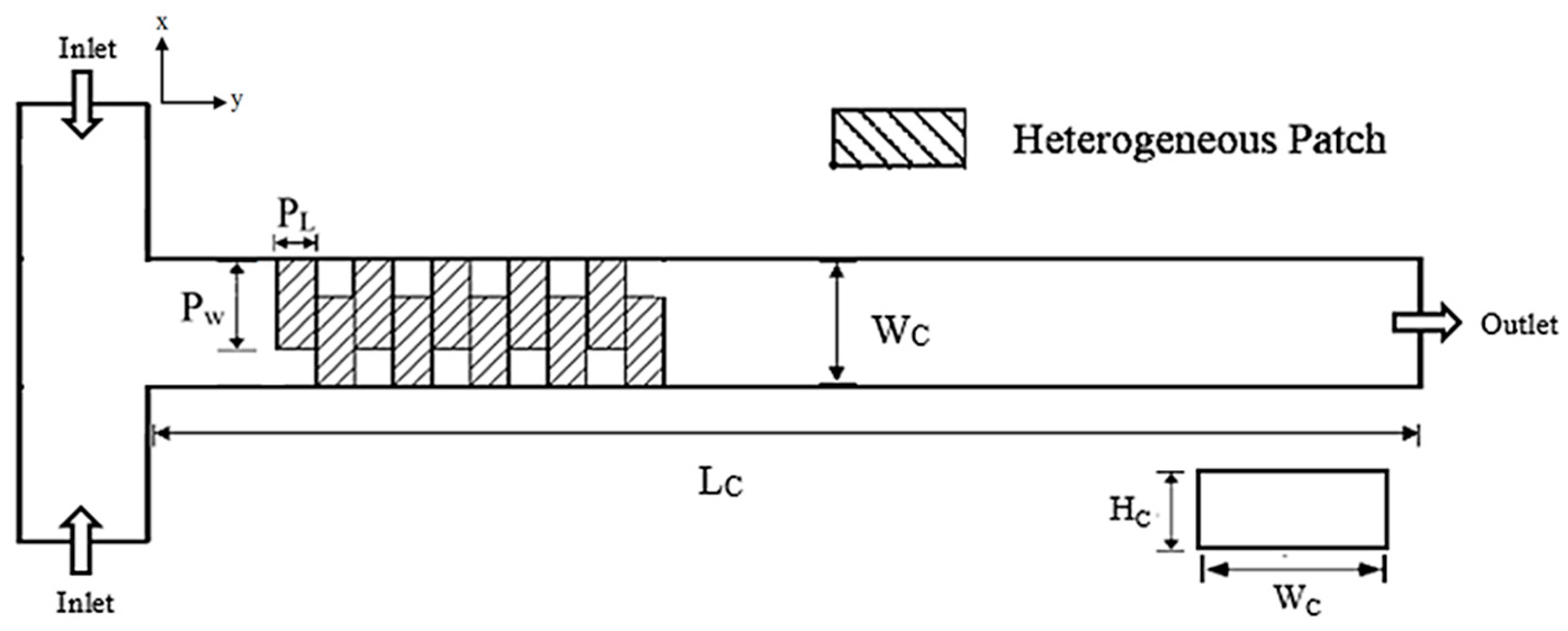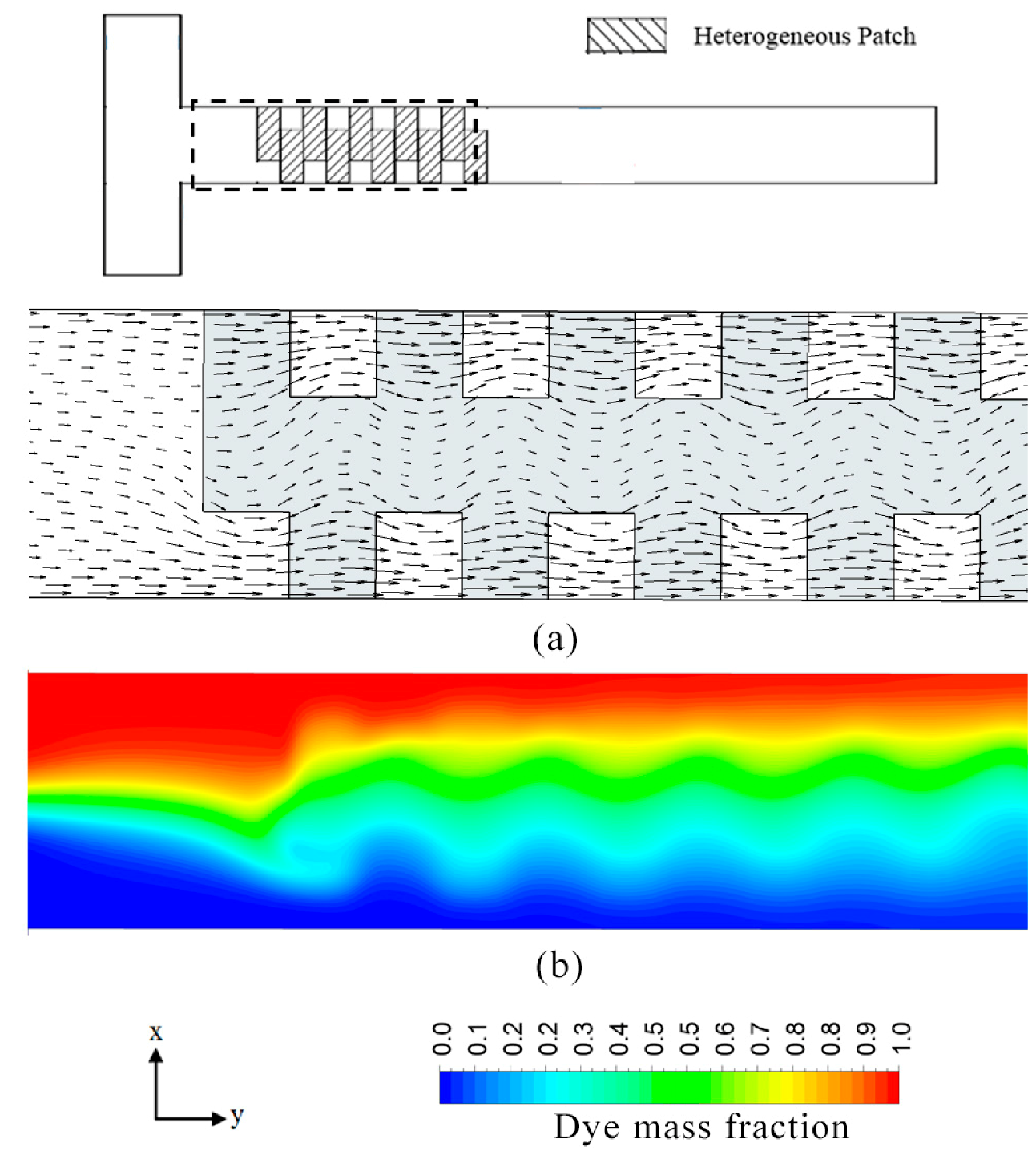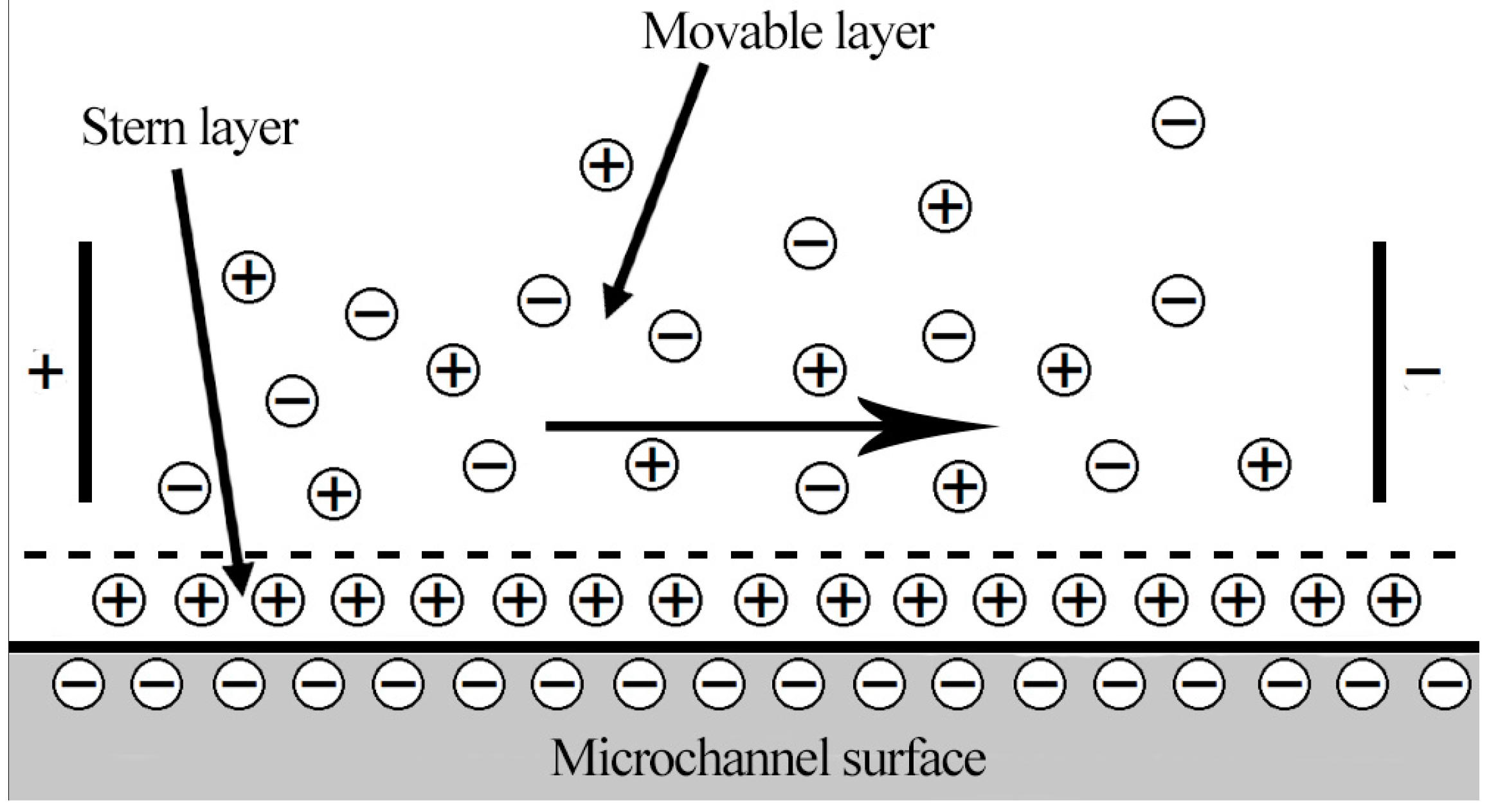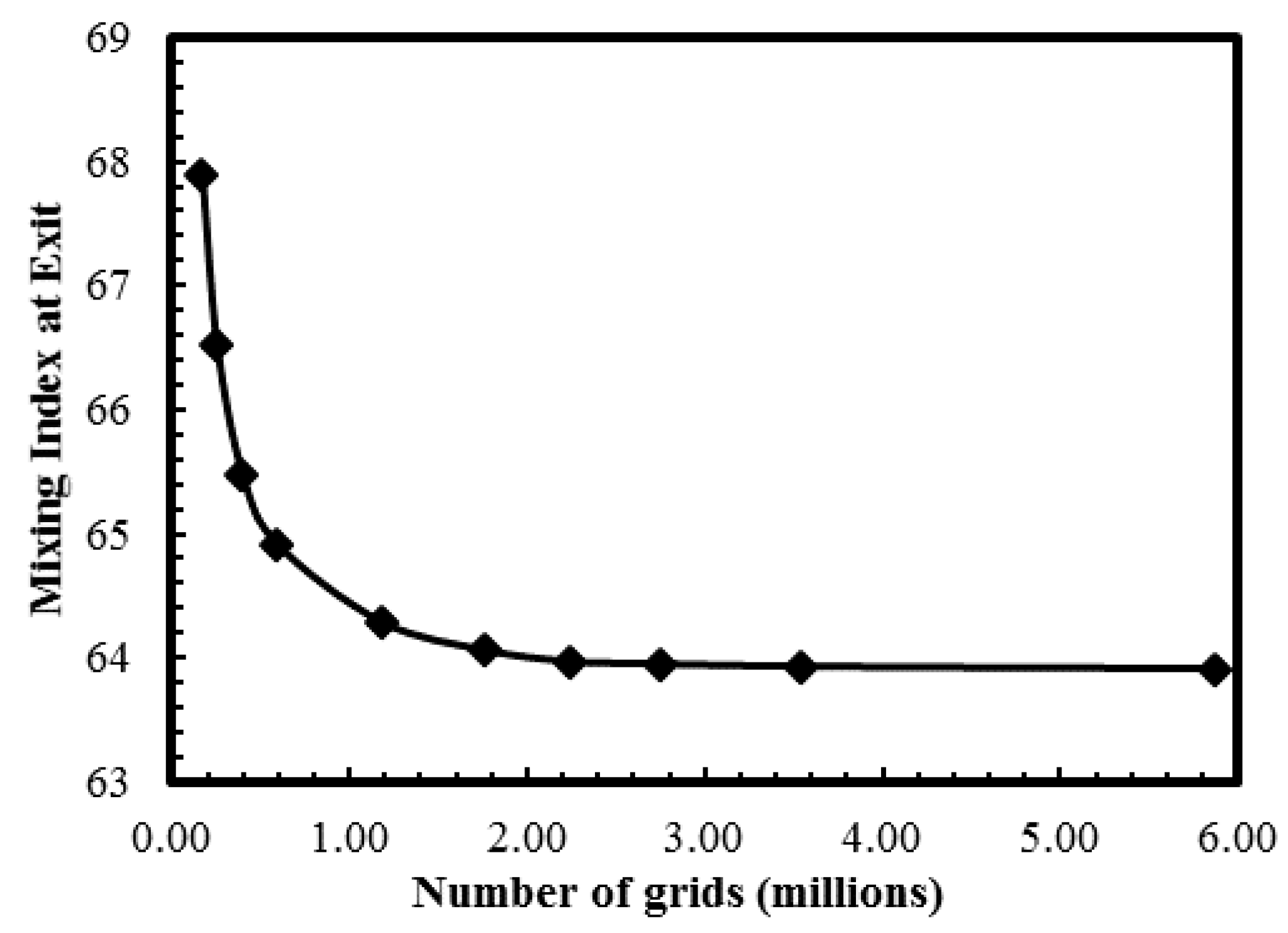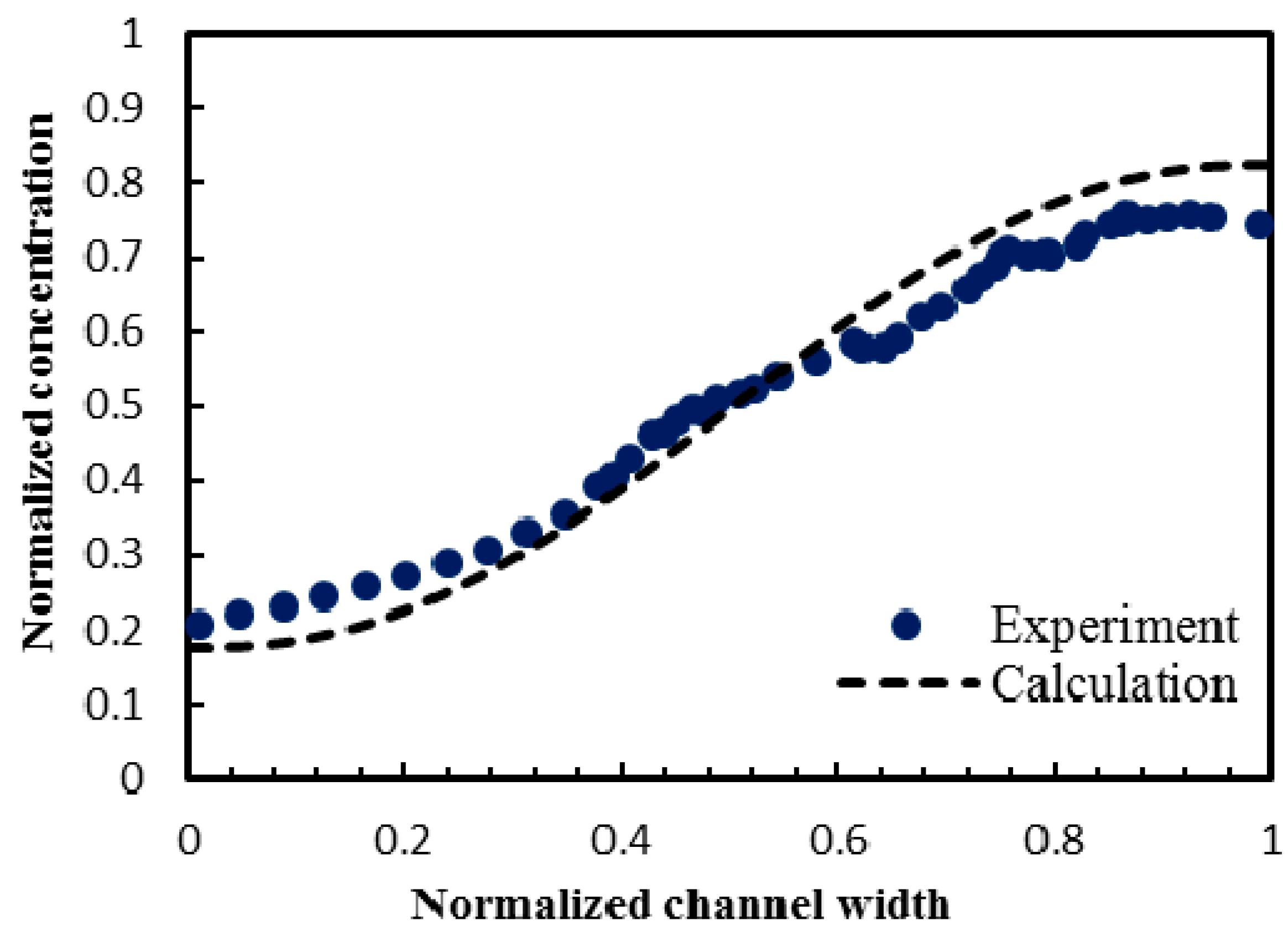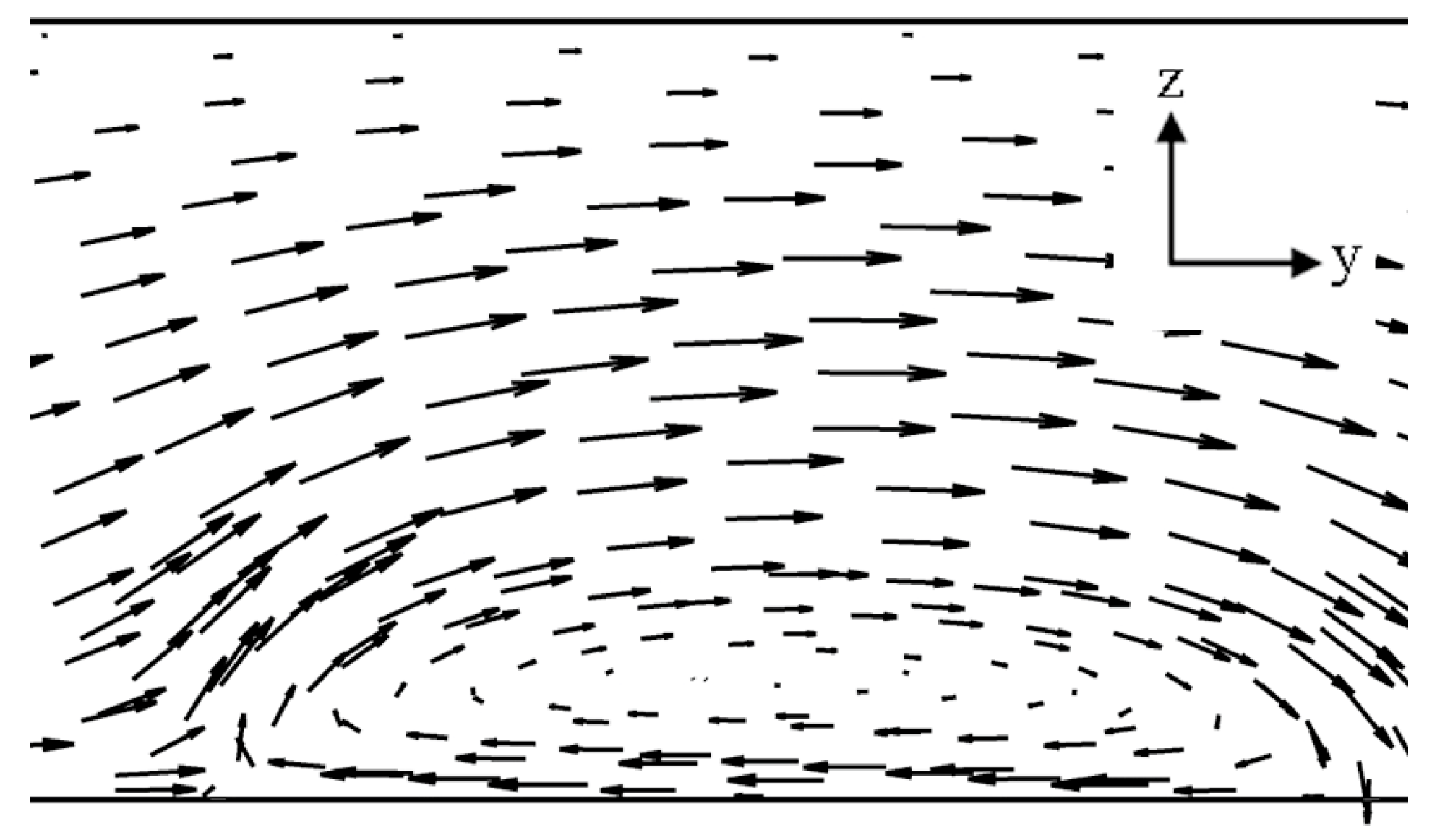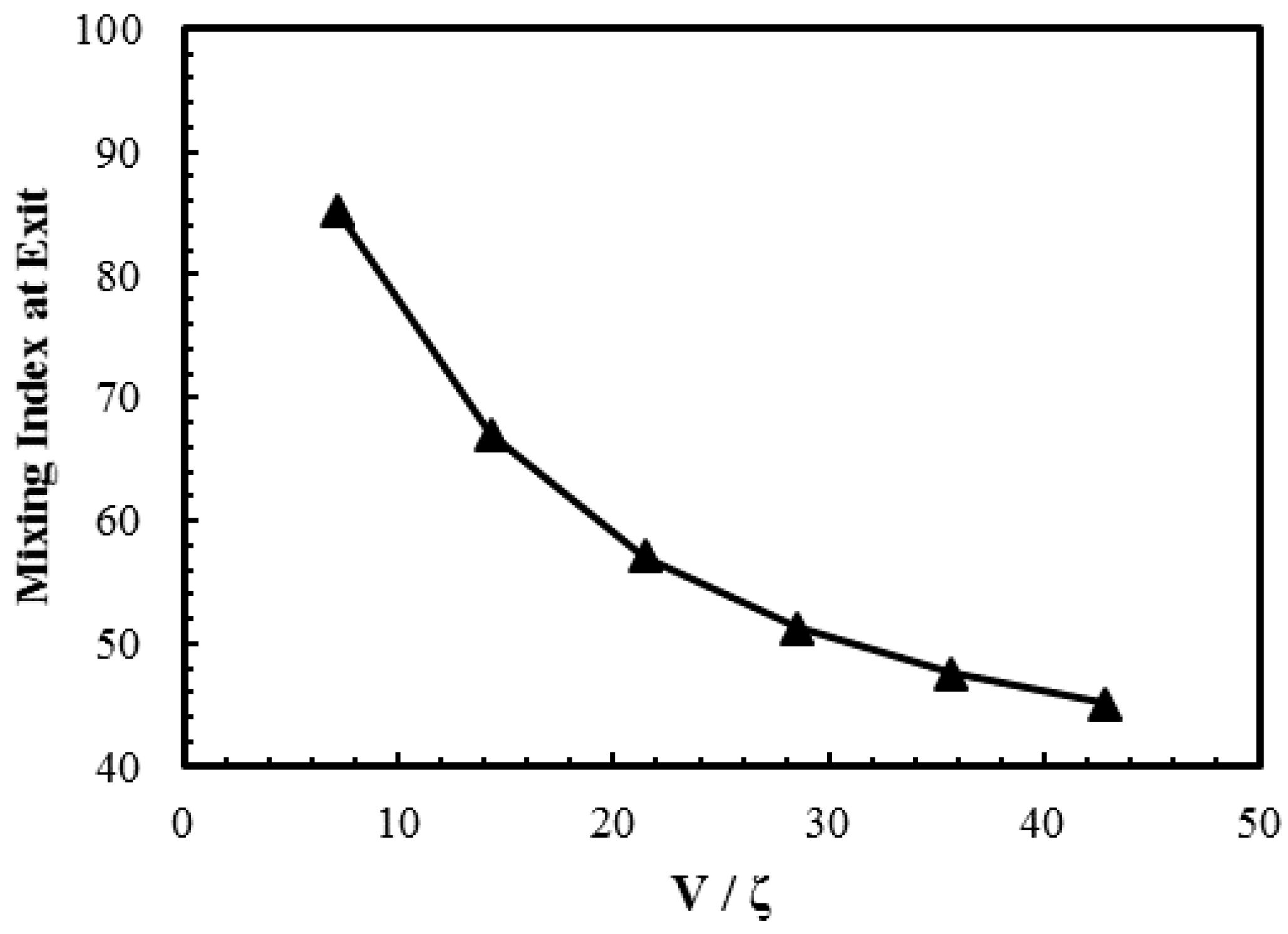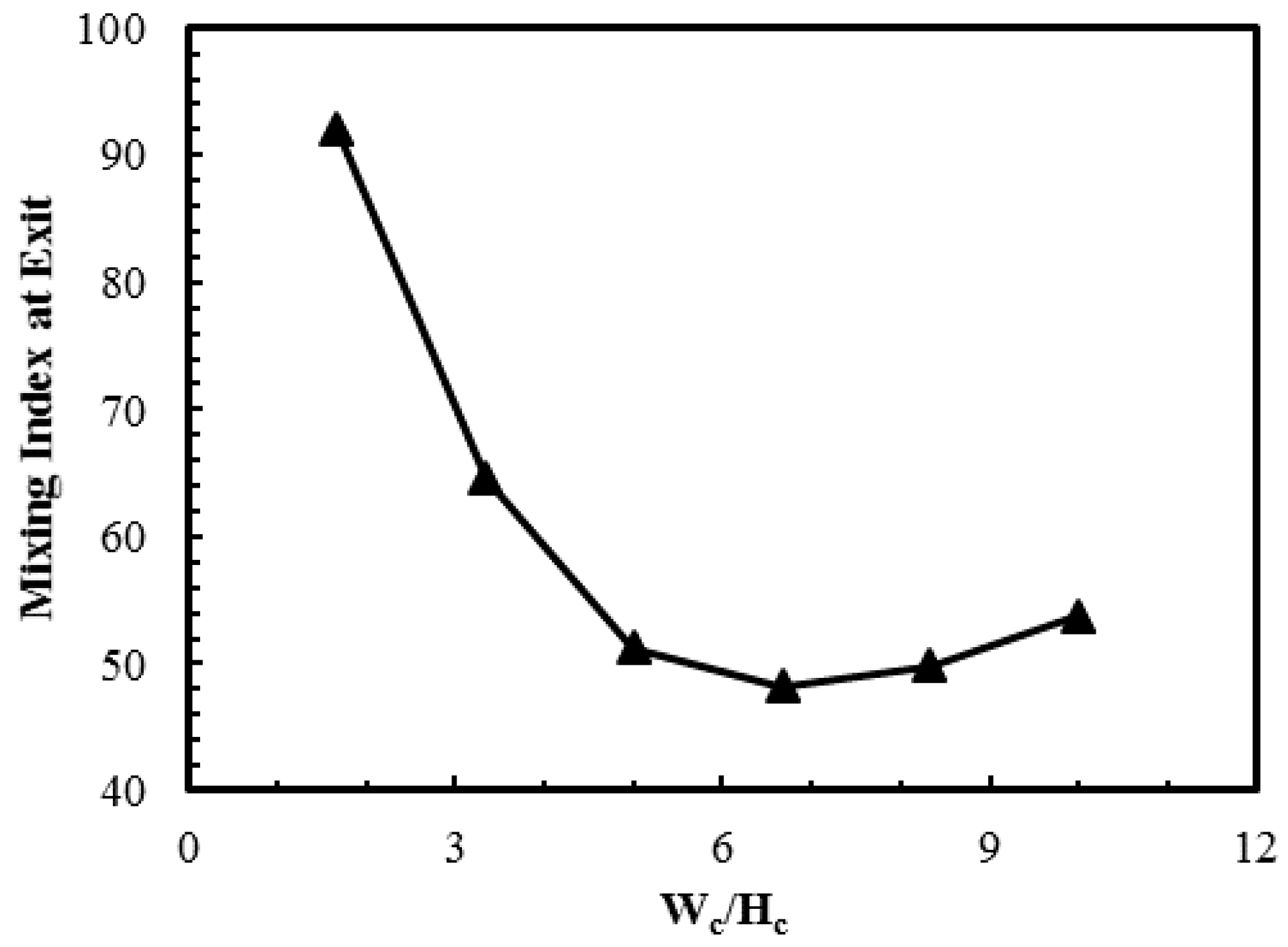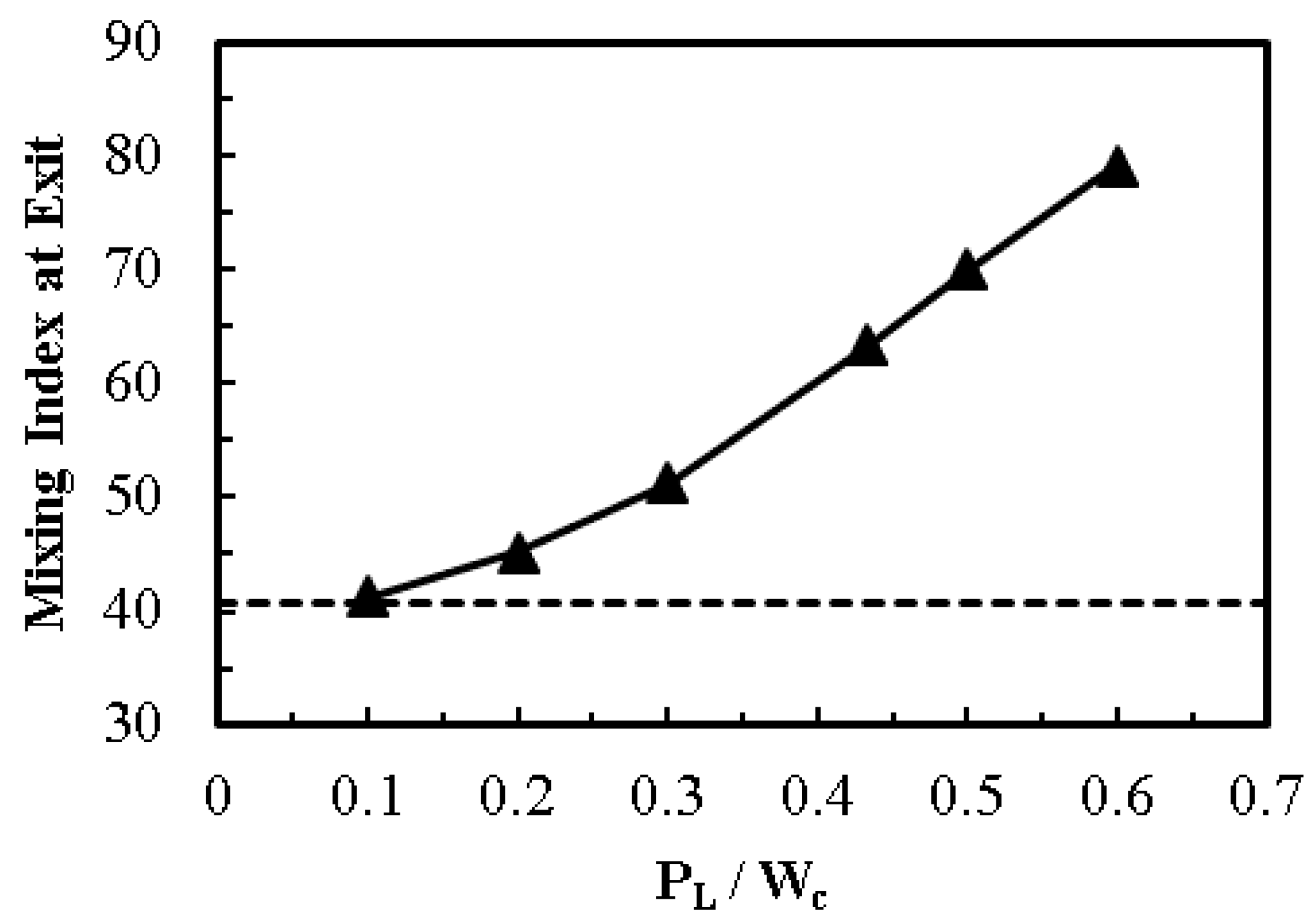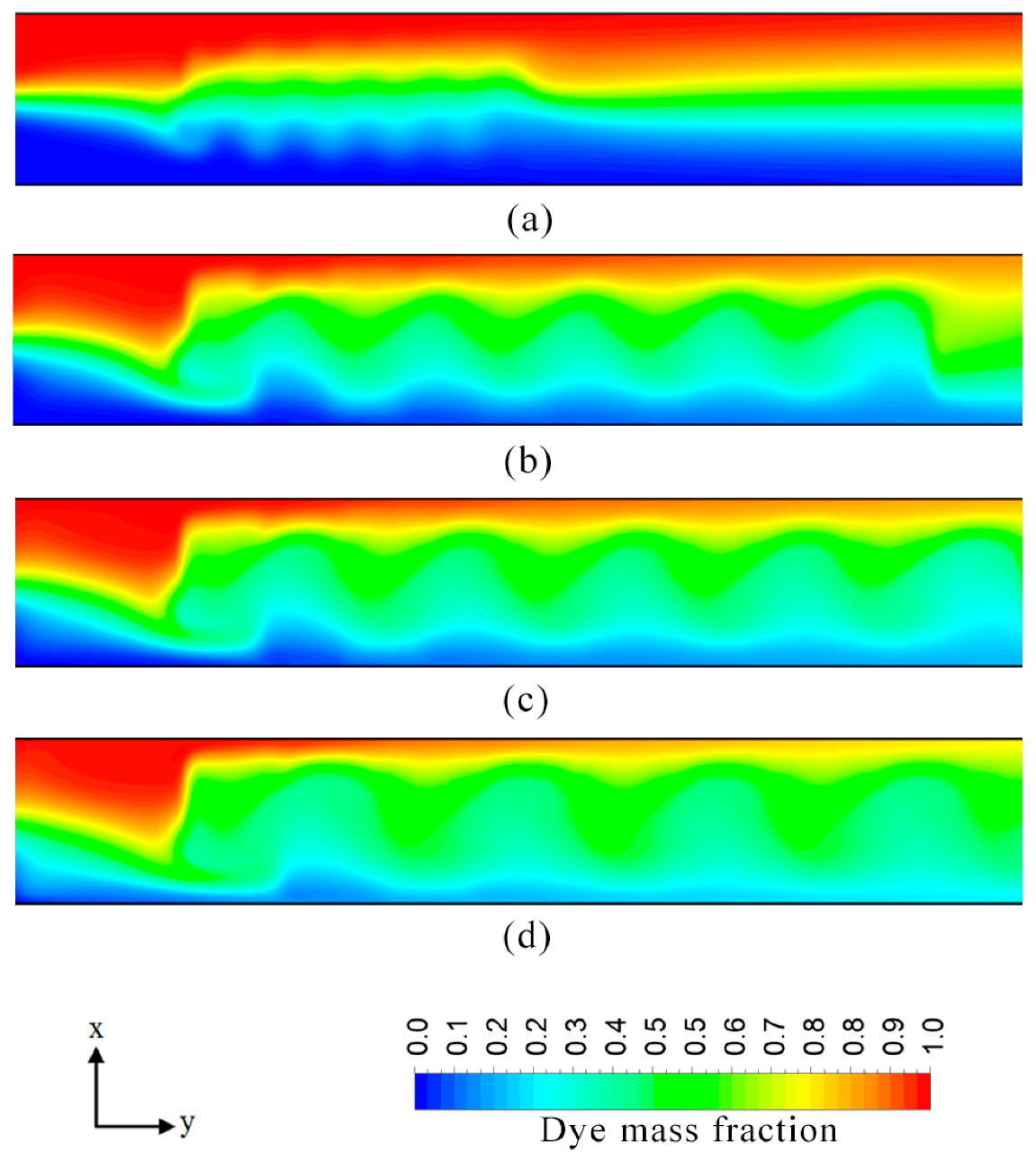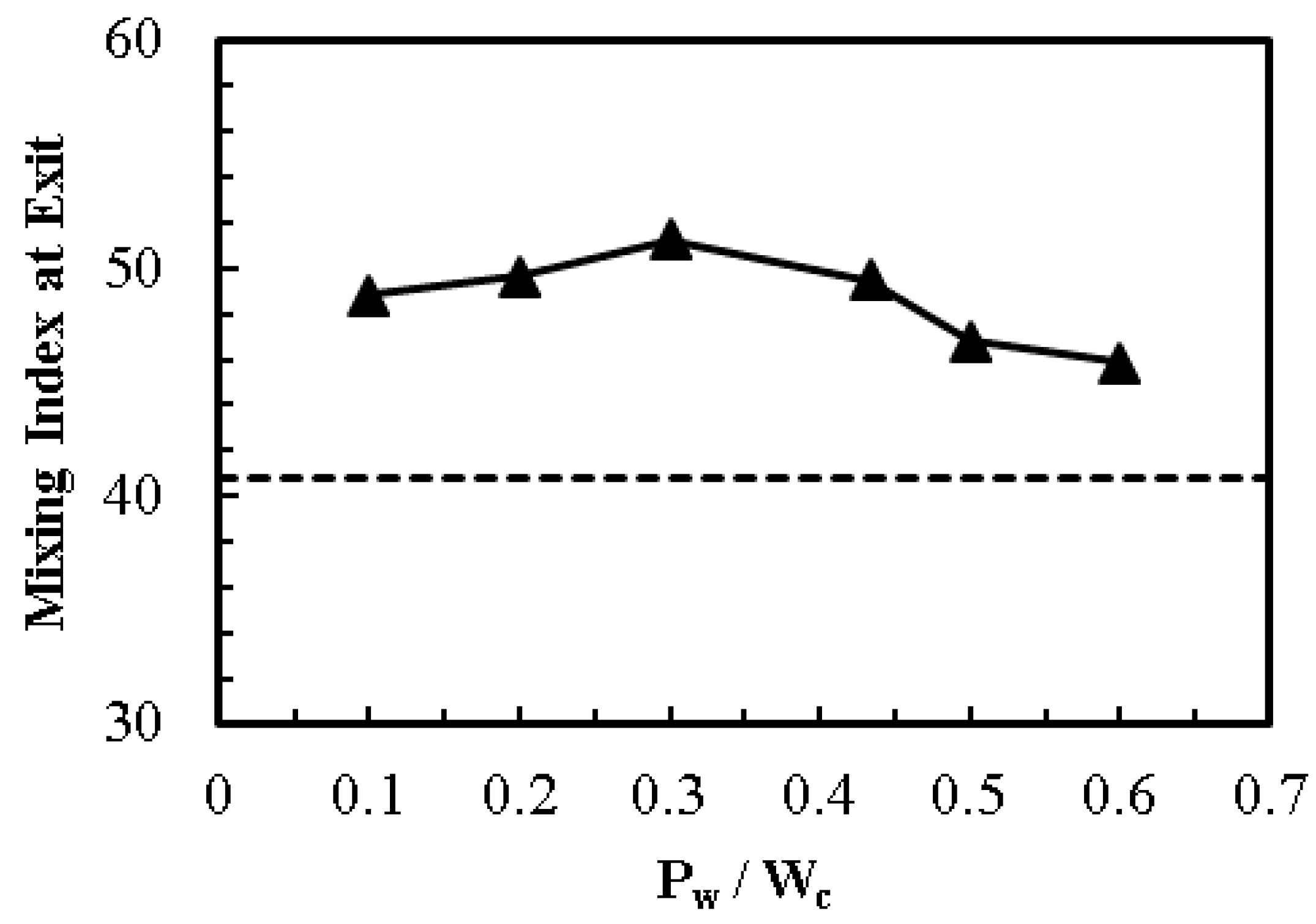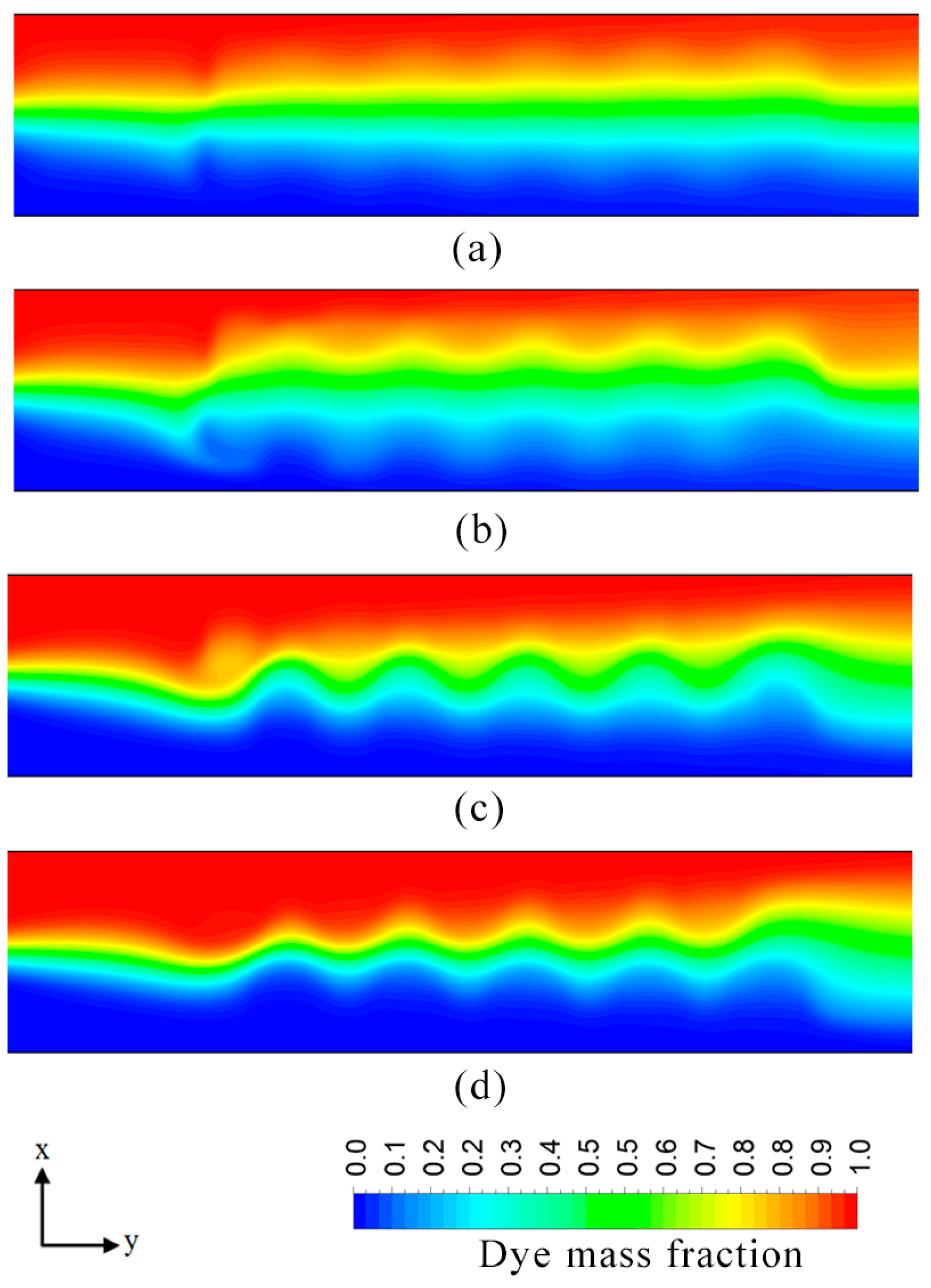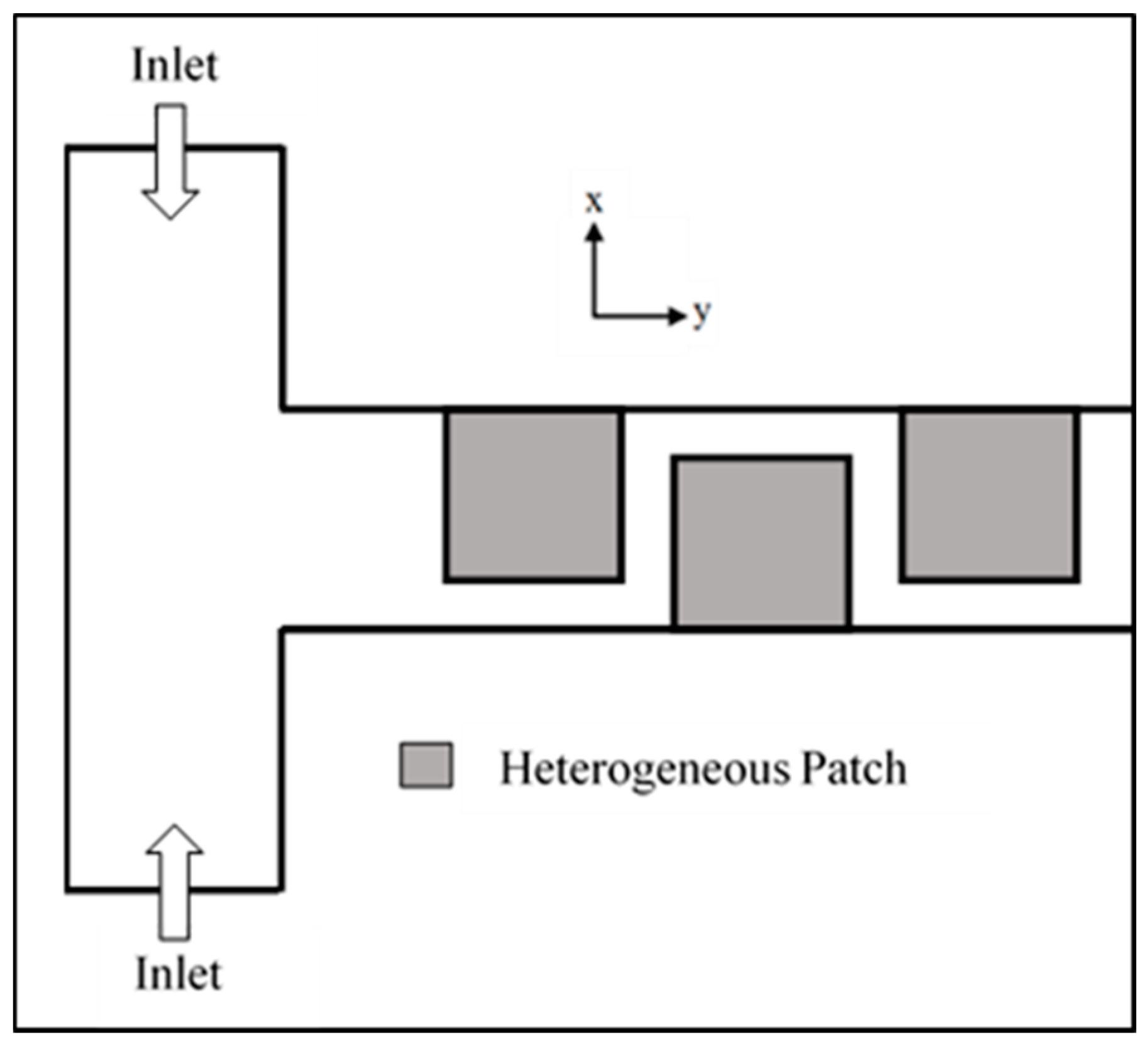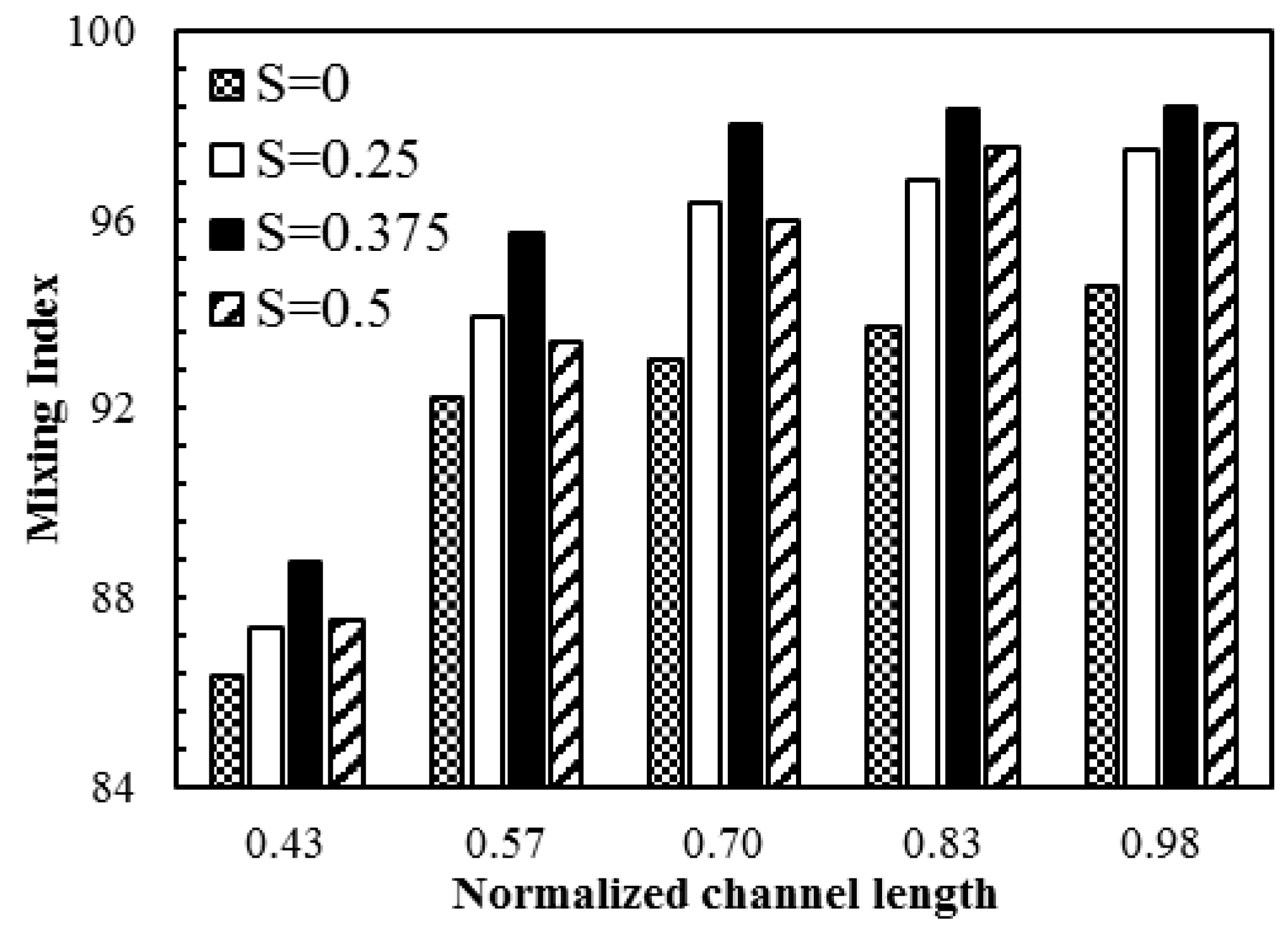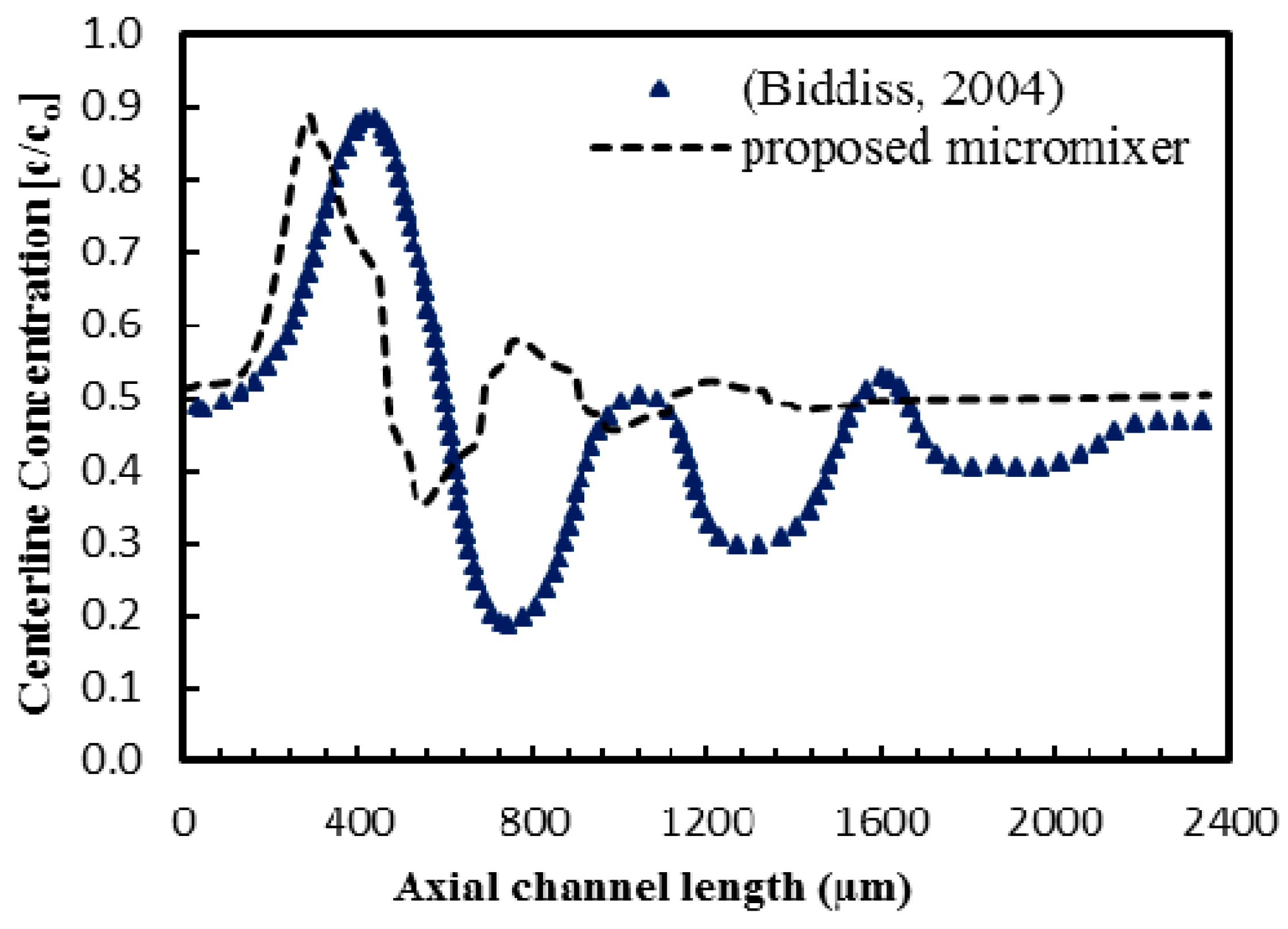1. Introduction
In recent years, noticeable advancements in microfluidics have been achieved in application to micro total analysis systems (μTAS) and lab-on-a-chip devices [
1]. When compared to their macroscale counterparts, these devices offer significant advantages like lower cost, higher performance, and reduced sample consumption. Thus, these microsystems gained considerable popularity and increased interest among biologists, chemists, and engineers, both in academia and industry. Device portability, enhanced mixing, and shorter analysis time are critical criteria of any efficient μTAS. Therefore, a rapid and efficient mixing process plays a key role in the development of microdevices. However, since characteristic dimensions of microfluidic systems are typically in μm scale, flow regime in such small dimensions is characterized by low Reynolds and Peclet numbers, and thus the mixing primarily relies on the slow process of molecular diffusion rather than advection. This requires larger channel length and mixing time to achieve homogenization of the species. Therefore, enhancing the efficiency of the mixing process is the primary objective in designing micromixers for μTAS applications to ensure the reduction in analysis time and size of the devices.
The micromixers can be categorized into active and passive mixers depending upon their mixing mechanism [
1]. Passive micromixers make use of geometry to produce complex flow fields for efficient mixing. They do not require any moving parts and can be easily manufactured in both planar and three-dimensional configurations. Passive micromixers rely on the mechanisms like split and recombination of flow, flow separation, chaotic advection and hydrodynamic focusing. Generally, passive mixers are preferred because of their simplicity of design, ease of manufacturability and system integration. However, passive mixing methods present less efficient mixing than active type mixers, and thus have the disadvantages of longer mixing time and channel lengths, and high pumping power requirements. Active micromixers use external energy or stimuli to enhance the mixing of fluid species. They feature either moving parts [
1] or externally applied forcing functions such as electric fields [
2], magnetic fields [
3], and pressure [
4]. Though they require relatively shorter mixing time and channel length, active micromixers are more complicated and difficult to integrate compared to the passive ones, especially if they require any moving part. However, active micromixers featuring simple electroosmotic flow have a simpler design without any moving parts, and thus they offer enhanced flow control with ease of manufacturing and implementation.
A lot of research has been carried out on electroosmotic micromixers. Different strategies were suggested and tested to manipulate and control the fluid motion in these micromixers; Chen and Cho [
5] introduced the concept of an embedded non-conducting obstacle on the microchannel wall. Heterogeneously charged obstacles were used by Chang and Yang [
6] to improve the mixing performance. Slanted grooves were used by Johnson [
7]. The mixing mechanism using heterogeneous surface charge patches is an effective and relatively easy to be implemented for mixing enhancement. The heterogeneous surface charge could be introduced on the sidewall and/or the bottom of the microchannel [
8,
9,
10]. This technique of introducing surface heterogeneity capitalizes on induced localized non-axial flow structure or vortices to achieve high mixing efficiency. Similarly, localized flow vortices could also be generated by using non-uniform surface potential/charge. Previous works [
9,
10] revealed how these induced non-axial flow structures could be manipulated by introducing heterogeneity at the bottom of the microchannel to achieve high mixing performance. Biddiss et al. [
8] compared the mixing performances of different configurations of heterogeneous charge patterns and determined that a staggered pattern is optimal for a very low aspect ratio geometry. Using particle tracking method, Chang and Yang [
9] investigated mixing performances of three patterns: diagonal, asymmetric herringbone and symmetric herringbone.
In the present work, a configuration of staggered heterogeneous patches in an electroosmotic micromixer was investigated numerically to develop a better understanding of the mixing mechanism inside the micromixer and finally to enhance the performance of the micromixer. This pattern of patches was used in a previous work [
8], where an in-depth analysis of flow structure and impact of surface heterogeneities on mixing performance was not performed. Performance of the micromixer was evaluated in a parametric study by solving three-dimensional Poisson-Boltzman and Navier-Stokes equations for a pure electroosmotic flow with a diffusion-convection model for species concentration. Effects of electrical double layer (EDL) and applied electric field on the flow were incorporated by introducing corresponding body force into Navier-Stoke equations. Findings of this study were utilized to develop a micromixer design which can provide enhanced mixing performance over shorter channel length.
3. Electrical Double Layer and Numerical Model
Fluid bulk motion induced by externally applied electric field in the presence of EDL near the surface of the microchannel, was modeled as a pure electroosmotic flow. The walls of the microchannel in most μTAS systems are made of dielectric material (e.g., silicon). When an aqueous solution comes in contact with the channel wall, the interaction yields net surface charge density. The surface charge density depends on the surface hydrolysis, adsorption or dissolution of ions and other reactions. The oppositely charged ions (counter ions) in the aqueous solution move towards the wall to form an EDL, as shown in
Figure 3. The EDL has counterions in excess, while outside EDL both coions and counterions have uniform concentration. If an external electric potential is applied across the microchannel, a moveable layer of EDL gets activated, and movement of ions takes place. In the case of steady state, a plug-like fluid flow is generated as a result of the balance between the electroosmotic force on the ions in the diffuse layer and viscous drag force.
Mathematically, the electroosmotic force can be treated as a body force and introduced in the Navier-Stokes formulation [
11,
12]. Hence, the fluid flow is modeled using the continuity equation and the Navier-Stokes equations with an additional body force term due to the applied electric field:
Mass conservation equation:
The net charge density
can be described by the distribution of charges in the EDL. Three-dimensional extension of the EDL model suggested by Arulanandam and Li [
12] was used to describe the charge density distribution as:
Electrical potential and ion distribution are not significantly affected by convection in low Reynolds number (Re < 10) flows [
13]. The Reynolds number (
) is calculated using average velocity at channel exit (
u) and hydraulic diameter of the channel cross section (
d). Hence, electrical potential and ion concentration can be described using the equilibrium Boltzmann distribution equation [
14];
In case of symmetric electrolyte, the net charge density can be described as:
Substituting Equation (5) into Equation (3), Poisson-Boltzmann equation can be obtained as:
The permittivity of the aqueous solution was taken as ε = 80. Since the externally applied electric field in this study does not exceed 1000 V/cm, the Joule heating effect is negligible and thus was ignored [
15]. In this work, 10
−3 M KCl electrolyte solution was used as the working fluid. The physical properties of the working fluid were set as follows; ρ
f = 10
3 kg/m
3 and μ
f = 10
−3 Ns/m
2. The diffusivity coefficient of the scalar dye was set as 3 × 10
−10 m
2/s.
The flow was assumed to be laminar and steady, and the mixing process was assumed to be isothermal. No-slip boundary conditions were applied at interior walls of the channel. As the flow was modelled totally electrokinetically driven, the pressures at the inlets and outlet were specified as zero. Electric field E was applied uniformly across the entire channel length.
The numerical simulations were carried out using a commercial finite volume solver CFX 15.0 [
16] with added customization to incorporate the electric potential equations. The solver used the coupled algebraic multigrid method [
17]. For convergence criteria, the root-mean-square residuals for all governing equations were set to 1.0 × 10
−6. The computations were performed by the Intel Core I7 CPU having 3.6 GHz CPU, and the computing time per single simulation was about 8–48 h with approximately 600–1600 iterations for convergence varying in accordance with the preset condition.
6. Results and Discussion
In this study, impact of the selected four parameters on the flow structure and mixing performance of the electroosmotic microchannel, featuring heterogeneous staggered patches, was analyzed. The multiple staggered heterogeneous patches inside the homogeneously charged channel cause flow vortices on
y-
z and
x-
y planes. Each heterogenous patch induces a vortex on the
y-
z plane as shown in
Figure 6, and another vortex on the
x-
y plane at its lateral edge shown in
Figure 7a. The later vortex generated by the alternately placed patches plays a critical role in enhancement of mixing performance by enlarging interferential area between the two mixing fluids.
Since heterogenous patches were introduced at the bottom of the microchannel, strength of the vortices reduces as the channel height increases.
Figure 7 shows the velocity vector plots on the
x-
y planes at two different
z/
Hc. These plots indicate that the induced flow vortices decay with the increase in the channel height, and finally change to a wavy motion as shown in
Figure 7b. For
z/
Hc larger than 0.33, the flow vortices are critically weakened, and thus do not contribute significantly towards the mixing enhancement. Therefore,
z/
Hc = 0.33 can be considered as the optimal channel height for heterogeneously charged electroosmotic micromixer featuring a passivated top layer. It should be noted that the optimal channel height can be increased by introducing additional heterogeneous charged patches on the non-passivated top layer. These top layer patches would induce additional vortices, thereby yielding a higher mixing performance. The induced wave at
z/
Hc = 0.33 is shown in
Figure 2. This wave can be characterized using three factors, namely, wave amplitude, wavelength and shape form. The profile of the induced wave plays a critical role in the mixing. This study includes a qualitative analysis on the effects of the selected parameters on the flow structure of the induced wave motion.
The main driving force for the electroosmotic flow is determined by the electric field applied across the channel. The electric field determines magnitude of the average flow velocity, and has a very strong influence on the induced flow vortex and mixing of fluid species; a low value of electric field tends to enhance the diffusive mixing by intensifying vortex and extending the residential time of the fluids in the channel. In order to study the effect of an externally applied electric field on the mixing performance, the reference design was tested over a wide range of externally applied voltages, as shown in
Figure 8. This figure highlights the trend between the externally applied voltage normalized by zeta potential and the mixing index measured at the exit of the microchannel. Higher voltage causes a decrease in the residential time which decreases the mixing performance considerably, especially in the case of the inefficient heterogeneously charged pattern. It can be observed that, as the normalized voltage decreases to below 28.5, the mixing index increases rapidly. In contrast to the mixing index, Reynolds number increases linearly as the applied voltage increases. Normalized voltage (
V/ζ) values of 7.14 and 42.8 yield Reynolds numbers of 0.01 and 0.04, respectively. The
V/ζ value of 28.5 which corresponds to the electric field value of 400 V/cm, was selected as the reference value in the parametric study.
Effect of channel aspect ratio (
Wc/
Hc) on the performance was analyzed by varying the width of the channel.
Figure 9 shows variation of mixing index at the outlet with the aspect ratio. The mixing performance of the microchannel decreases steadily as the channel aspect ratio increases from 1.65 to 6.65. However, further increment in the value of aspect ratio results in a small yet observable increase in the value of the mixing index. An increase in the channel width impacts the mixing performance negatively since it increases the distance between the opposite near-wall streams of the two fluids. Therefore, the mixing process which relies primarily on diffusion gets hindered excessively. Dye mass fraction distributions in the microchannel for two different aspect ratios are illustrated in
Figure 10a–d. Increase in the channel aspect ratio increases width of the wave. However, the aspect ratio does not significantly affect the other features, such as amplitude, wavelength and waveform, and thus does not contribute excessively to mixing. The better mixing performance of
Wc/
Hc = 3.33 compared to that of
Wc/
Hc = 8.33 can be attributed to the smaller diffusion distance. The former case shows a comparatively lesser degree of homogenization of species in the mixing region, but higher a degree of mixing near the exit. The slight increase in the mixing index for the aspect ratio values higher than 6.65, can be explained by the fact that an increase in the channel width is accompanied by the increase in the total area of the heterogeneously charged surface at the channel base wall. This results in the relatively lower bulk velocity and slightly higher retention time, and thus the mixing performance is improved slightly.
The ratio of patch length to channel width (
PL/
Wc) significantly affects the mixing performance of the electroosmotic microchannel, as shown in
Figure 11. Increasing the patch length rapidly increases the mixing index. An increase in the value of
PL/
Wc from 0.3 to 0.6 increases the mixing index by 28%.
Figure 12 shows dye mass fraction distributions in the microchannel for different
PL/
Wc. Alteration in the value of patch length (
PL/
Wc) significantly modifies the wave motion. An increase in the value of surface patch length (
PL) increases the wavelength and amplitude of the induced wave resulting in the expansion of the interfacial area. The other noticeable effect is the reduction of distance between interfacial area and each near-wall stream of a fluid, which enhances diffusion and mixing performance. In this study, value of
PL/
Wc up to 0.6 was analyzed. This value can be extended further to intensify the homogenization process. The increased patch area would also slow down the bulk velocity inside the microchannel. Excessive heterogeneity (patch area) may result in a very low Reynolds number which may render the micromixer unsuitable for certain practical applications.
Changing the ratio of patch length to channel width (
Pw/
Wc) does not show significant effect on mixing performance, as shown in
Figure 13. The mixing performance is at its maximum at
Pw/
Wc = 0.3. Deviation from this value causes a decline in the overall mixing performance of the micromixer. Dye mass fraction distributions for different values of
Pw/
Wc are shown in
Figure 14. It can be observed that excessive increase in the patch width decreases the width of the homogenous sections wedged between two adjacent heterogenous patches. These reduced homogenous sections are unable to induce the fluid velocity required to achieve strong flow vortex, as shown in
Figure 7. Similarly, a decrease in the patch width below an optimal value brings the induced vortices closer to the centerline of the microchannel. Consequently, the reduced patch width increases the amplitude of induced wave, and thus increases the widths of fluid streams in the near-wall regions, resulting in a decrease in the mixing performance.
To further improve the mixing performance, a modification of the micromixer design by introducing space (
PS) between the two adjacent heterogeneous patches was proposed and analyzed in this work. The proposed surface pattern is illustrated in
Figure 15. The flow field and dye mass concentration distribution obtained from the simulation for the new design are shown in
Figure 16. This spacing introduces an additional localized flow in a lateral direction, which enhances mixing between the two fluid streams. The velocity vector plots in
Figure 16a,b show the localized lateral flows induced in the space between the two consecutive heterogeneous patches at
z/
Hc = 0.3 and 0.6, respectively. The additionally introduced spaces affect the shape of the induced wave. The wave form exhibited resemblance to a square wave as shown in
Figure 16c, which enlarges the interfacial area between fluids.
It was found in this study that channel width and patch length have the most profound effect on mixing performance. An increase in the patch length and a decrease in the channel width enhanced the mixing performance significantly, however, it caused a critical reduction in the mass flow rate. The patch width was found to have a relatively small effect on the mixing performance. Similarly, the optimal channel height was found to be 10 μm. Based on these findings, a modified micromixer design was contrived. The following dimensions were selected for the modified micromixer design: Wc/Hc = 12.5, PL/Wc = 1.06, Pw/Wc = 0.70, S = 0.375, and Hc = 12.0 μm. In order to ensure sufficient mass flow rate, the values selected for the channel width and height were slightly greater than the optimal values. As discussed earlier, Pw/Wc did not affect the mixing index in a significant manner in the reference geometry. However, in the case of PL/Wc = 1.06, a higher value of Pw/Wc showed better mixing performance as it was observed to push the interfacial area between fluids away from the centerline towards the channel wall, thereby decreasing the diffusion distance.
The modified micromixer was then tested for different values of patch spacing to identify the optimum space value.
Figure 17 shows the developments of mixing index along the channel length for different values of
S (=
PS/
PL). All the modified designs with non-zero S show better mixing indices than the conventional design (
S = 0). And, an optimum space (
S = 0.375) shows the best mixing performance throughout the channel length. This optimum space (
S = 0.375) was incorporated into the modified design. The new design shows excellent mixing performance, yielding a mixing index of 0.95 within less than a half of the channel length (1 mm) and a mixing index of 0.99 at the channel exit (2.4 mm) for applied electric field (
E) of 280 V/cm. A comparative study was carried out between the modified design and the original design reported by Biddiss [
8] for the micromixer with staggered heterogeneous surface charge pattern. The dimensions of the proposed and the Biddiss’ micromixers are compared in
Table 2. The efficient heterogeneous patch configuration of the proposed design induces flow with greater interfacial area which enables rapid mixing over a shorter period of time compared to the Biddiss’ micromixer. Developments of centerline concentration along the channel length in the two micromixers are presented in
Figure 18, where the proposed design shows rapid homogenization and outperforms the Biddiss’ design by achieving the same level of mixing with a shorter mixing section.
